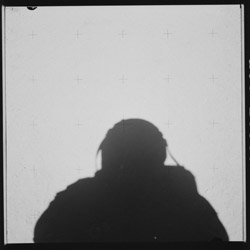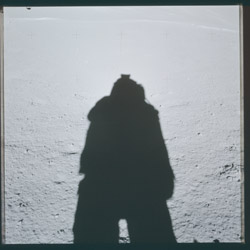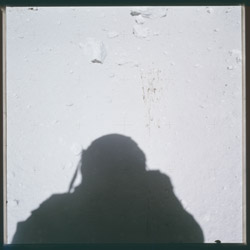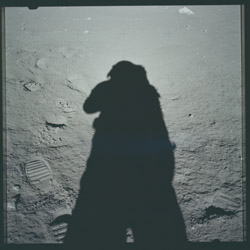
Some years ago a video appeared online claiming to show a secret Apollo mission, Apollo 20, launched in 1976 on a mission to the far side of the moon.
It claims, amongst other things, to show a hidden alien city on the moon, and a female alien held in suspended animation.
Many people believe this to be true, and certainly the maker of the video went to great lengths to make it appear that it was genuine.
There are many good debunking videos showing how some of the images have been derived, and I’ll provide links to them later.
What I intend to do here is to debunk the claim that it is filmed inside a genuine command and lunar module, and that the images are from a secret mission. I’m not interested in who did it, or why, I’m interested in how..
The video appears in 3 parts, and I’m going to look at the 2nd part first. Here’s one source for it:
I’ll start at the very beginning, as it’s a very good place to start, with the opening shot: a shaky view of an Apollo Command Module (CM) hatch window supposedly filmed in space. I will demonstrate two things: firstly, it is a genuine Apollo CM, and secondly it is nowhere near the moon but safely on the ground here on Earth.
Here’s a screenshot of the CM from the film:
It looks very convincing, so let’s see if we have a NASA image with which to compare it. As it happens, we do, this Apollo 17 photo taken with a Nikon 35mm camera: AS17-
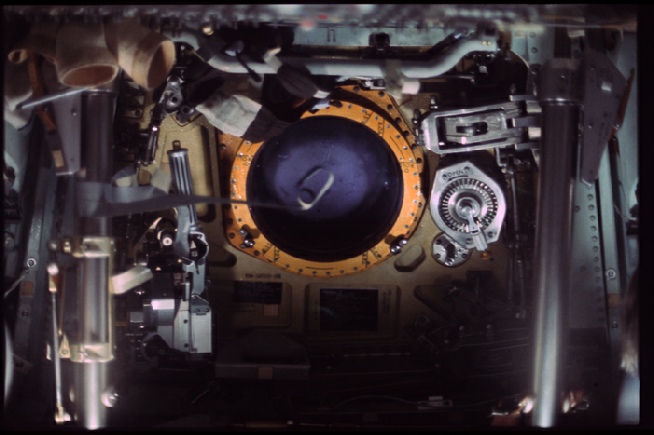
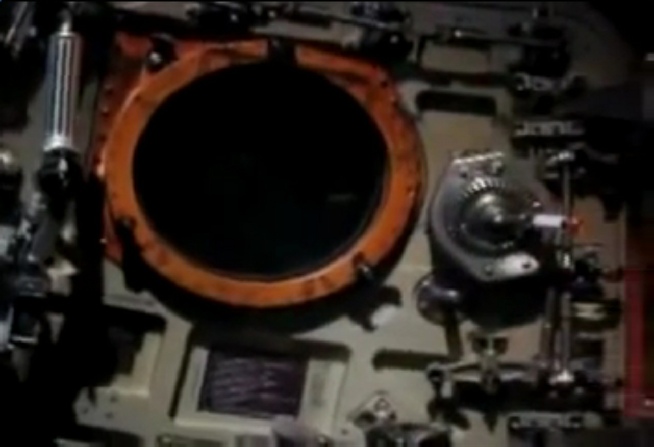
It certainly bears a strong degree of similarity with the screenshot, with the exception of one area to the right of the round hatch window. Let’s zoom in on the area and have a look.
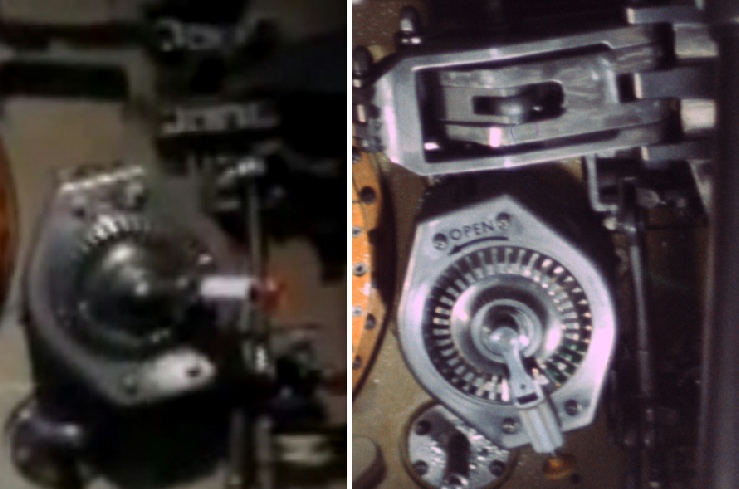
Hmm -
Thanks to some fouling observed on the windows in Apollo 12, there is one from that mission, AS12-
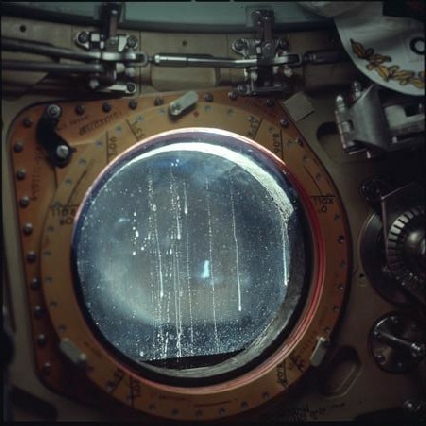
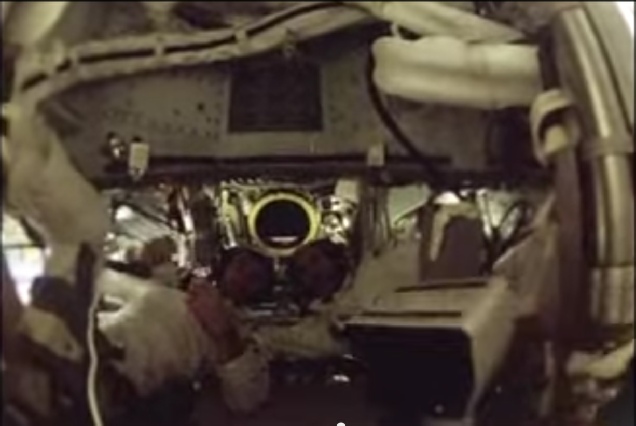
It should be quite obvious that there is a great big hinge attachment evident in both of them.
So, are there any examples of a CM door with that hinge arrangement. Well, yes there are, and here’s a very good example, taken from this website:
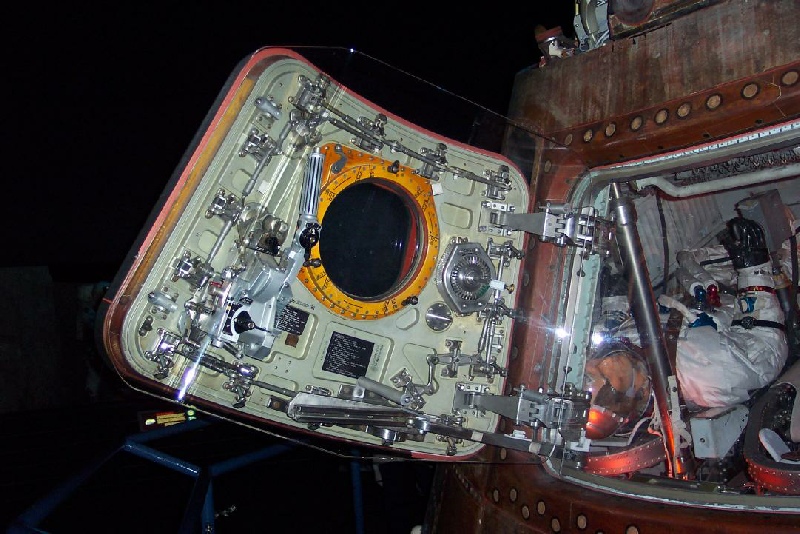
Notice anything? Apart from the staggeringly obvious fact that the hatch is wide open?
Shall we take a close up view of the hinge area? Yes, let’s do that…
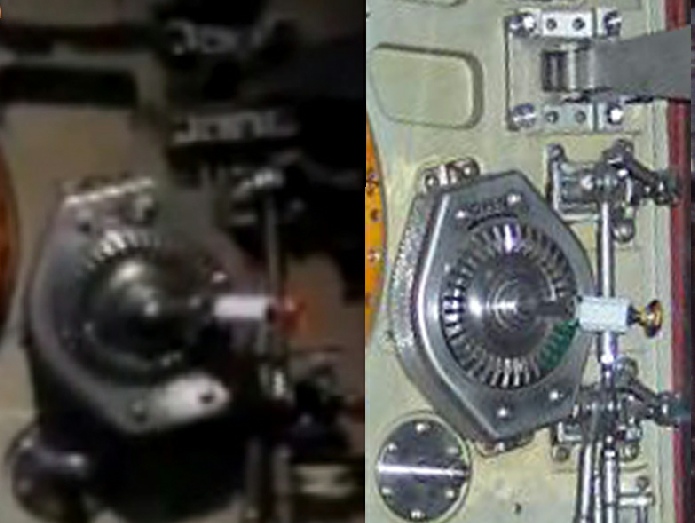
Notice the handle, and its orientation? It’s an exact match in the two images. Can you see how the baseplate to which the hinge is attached can be seen once the closing mechanism itself is out of the way?
Hopefully by now you will have realised that the reason the two match is because they are the same, and the reason that the hinge appears the way it does in the Apollo 20 video is because it was open when whoever made the film stood in front of the open hatch at Johnson Space Center, which is where this CM is on display. Not only that, it’s actually the Apollo 17 CM.
Can we be sure of that? Well, yes we can -

We can compare this with other CM hatches on on display, all culled from a very quick search for ‘Apollo command module hatch’.
Here, for example, is Apollo 11’s hatch (below left) and Apollo 8’s (below right):
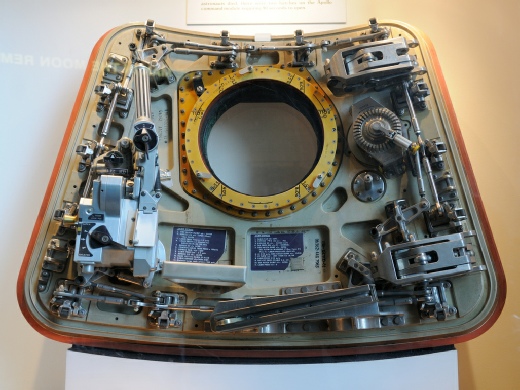
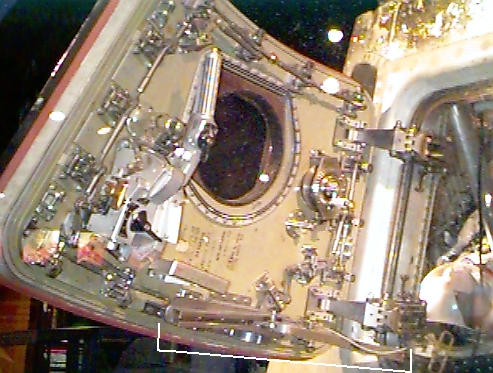
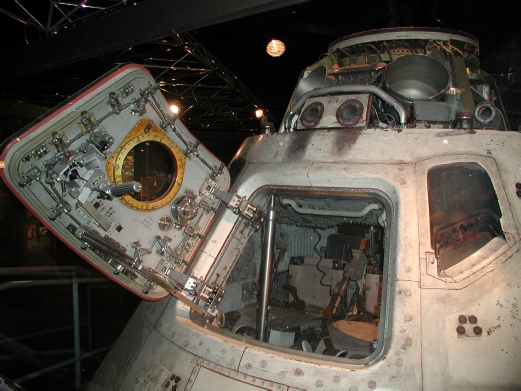
And here are a couple of unidentified ones on public display:
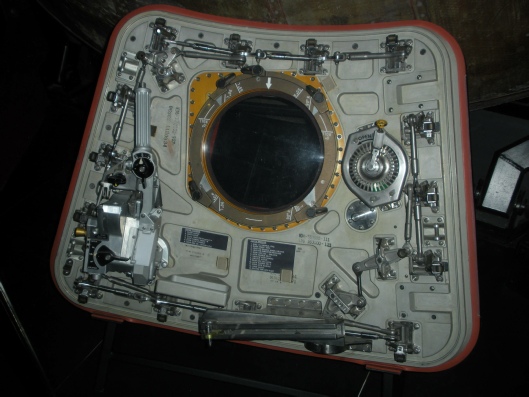
Should be pretty obvious that different mission CM hatches had slightly different designs, and I am more than happy to state with certainty that the Apollo 20 film maker walked up to the hatch of the Apollo 17 CM at JSC with a camera and filmed it.
The next scene in the film is more interesting, and they were slightly more inventive in the way they faked it. It starts with a shot of some dials and buttons, then pans up to show a mission patch and flag taped to the console. What is more challenging about this shot is that there are some flat ribbon cables that appear to give the shot depth and the illusion that they are filming inside a genuine CM.
My contention is that they are not, and I’ll explain why. Here are some screenshots from the footage
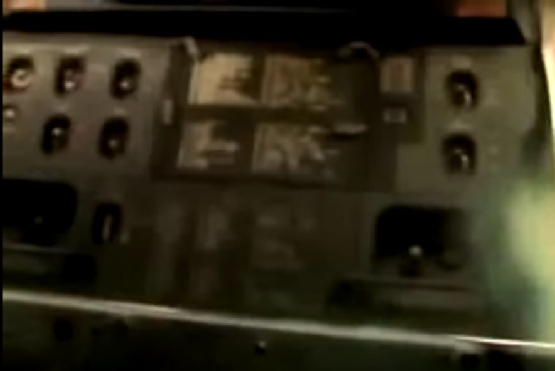
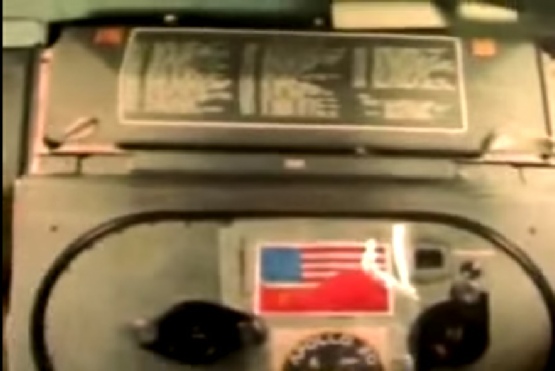
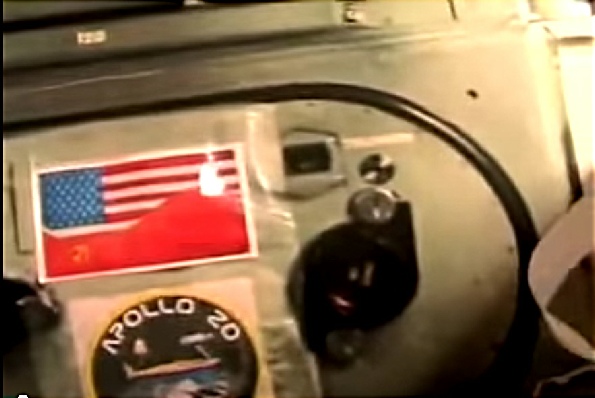
Now if only we had an interior view of the CM showing the same set of dials and buttons. Well, as it happens, we do, in the shape of AS17-
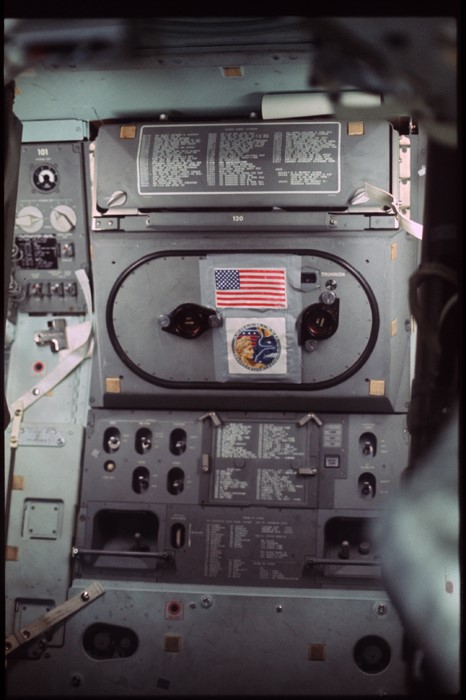
Let’s cut to the chase: This image was used to fake the CM footage from which I have taken screenshots, and I’ll explain why I know this is the case. First off, let’s take a look at the first screenshot, specifically the area to the right. In the image below I’ve zoomed in to it, and put it next to the same area in the Apollo image.
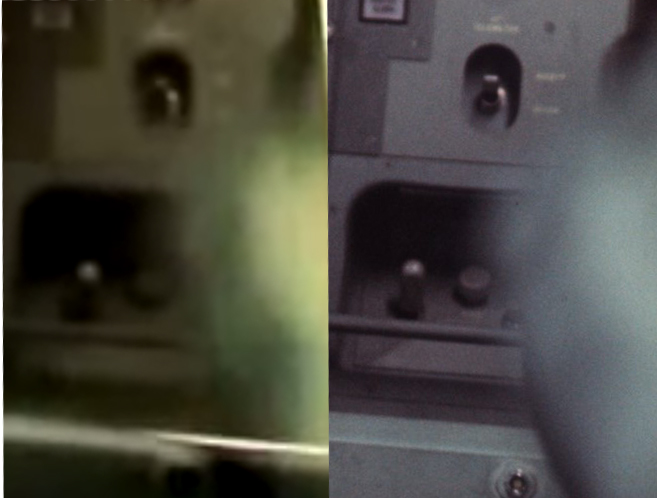
Now, I don’t know about you but I find it a remarkable coincidence that there is exactly the same blurring (thanks to an obstruction in both images), and that it also appears to be taken from exactly the same angle.
There’s another thing to be found in this first screenshot: in the centre of the still, towards the top, is a black area filled with text. It has around it several plastic tabs, used to secure paper to the console. These aren’t fixed items -
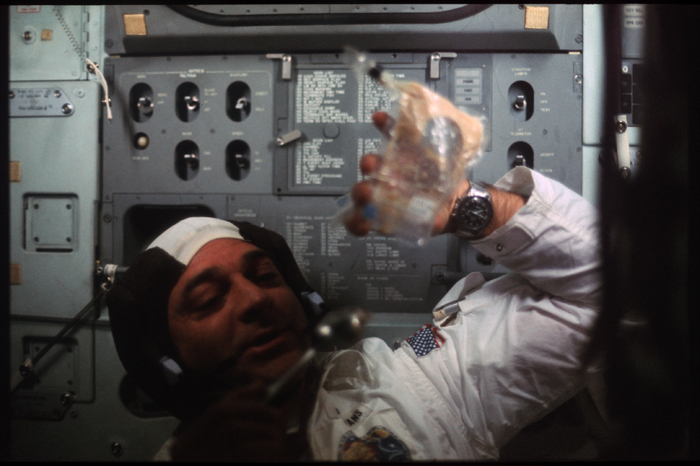
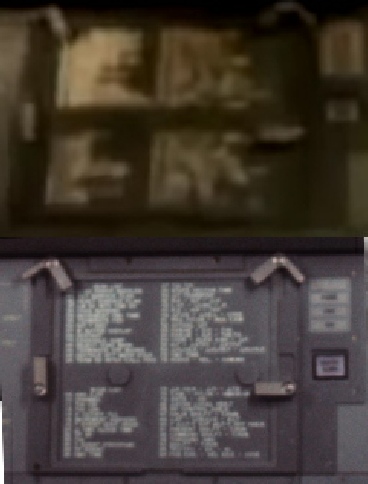
So, so far we have a blurred obstruction occurring in exactly the same spot in an Apollo 17 image and an Apollo 20 movie still, and we also have movable plastic retainers that are in exactly the same position.
Let’s now go to the second still, and I want specifically focus on the top part of the picture so that we can compare it with the Apollo 17 one.
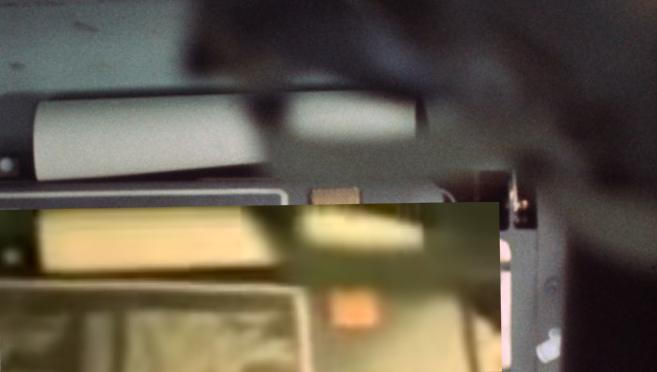
In case it isn’t obvious, the part of the video still I’m interested in is the bit where something is obscuring whatever piece of paper is wedged into the console. Whatever is obscuring it appears in exactly the same place and is exactly the same shape as something that is out of focus and in the foreground in the Apollo 17 image.
The final part presents more of a challenge, the mission patch and flag.
The flag itself is an edited version of the one used for the genuine US-


What is interesting, however, is the tape used to stick this flag and patch combination to the alleged Apollo 20 CM. Here’s a close up of one area from the Apollo 17 photograph and Apollo 20 still. Both images have been sharpened to the same degree to bring out the details:
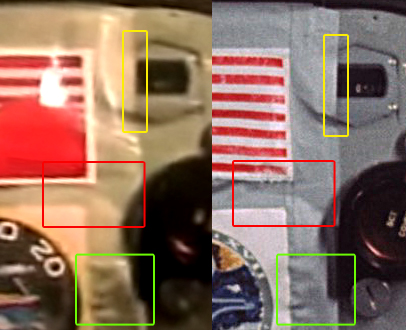
I’ve picked out the area in yellow to highlight the fact that the tape crosses a socket in exactly the same spot, something that continues further down the panel. While it isn’t inconceivable that two missions would secure a similar pair of items in roughly the same place, getting it in exactly the same place right down to where the sticky tape is positioned is pretty remarkable.
The area highlighted in red shows a roughly horizontal pair of long creases, again positioned with remarkable exactitude in two supposedly different missions.
Likewise the green area, where there are several short creases and ripples that are an exact match between the two images.
We have the same set of issues over on the other side of the flag.
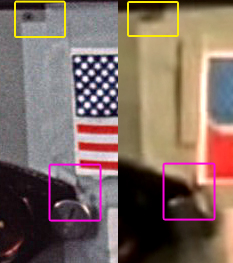
Again it is remarkable the tape should occur in exactly the same spot on the opposite side of the display, particularly in the area outlined in yellow where the same pattern of cut has been used at the ends. Likewise the creasing in the purple area as the tape is moulded around the switch area.
We have pretty much moved beyond the level of ‘remarkable’ and firmly into the ‘a bit more than a coincidence’ zone. My contention is that the image used to fake this part of the movie is from Apollo 17, with some crude edits to superimpose the new mission flag and patch.
The only thing left to explain is the impression of depth given by the tape:
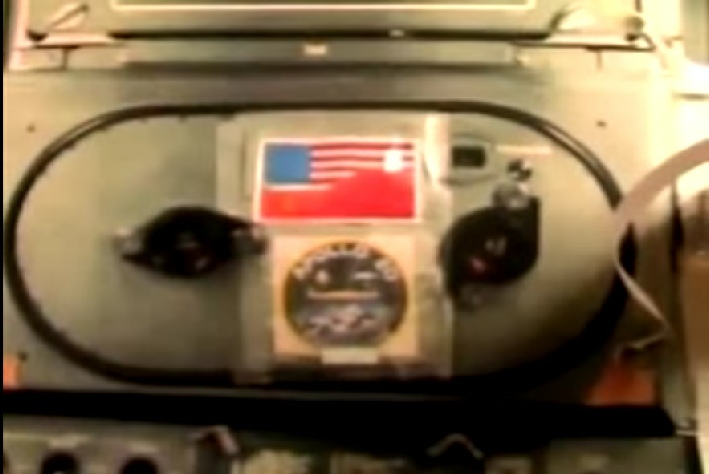
There is a really obvious answer: The image is printed out at a large scale, and tape is stuck to it. You then film it in a shaky ‘found footage’ style by moving the camera around and at odd angles to give the illusion of depth. At some point I’ll reproduce the effect myself to prove it!
Meanwhile, back in the mission footage, we move on to a view that seems to claiming to be over the moon. It isn’t, because not much of the moon has the kind of right angle structures you can see in this screenshot, an area of which I’ve zoomed into.
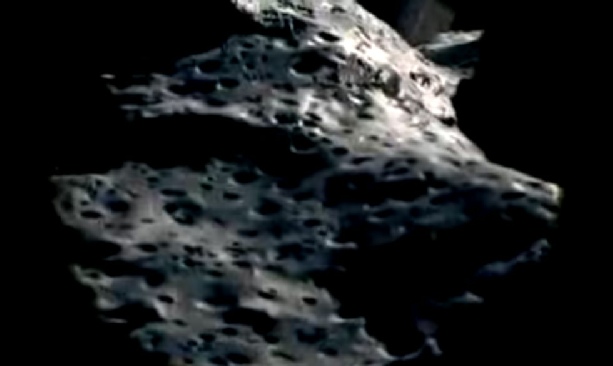
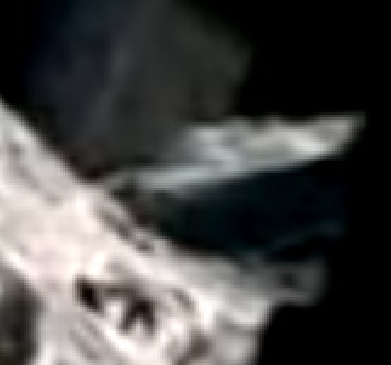
No doubt someone will claim that those structures are all part of mysterious spaceship, but when it cuts to that ship there isn’t anything on it that looks like that.
Neither does it successfully imagine that it is the surface of the moon -
We next spend some time hovering over the supposed ship, complete with fake heiroglyphs and pseudo-
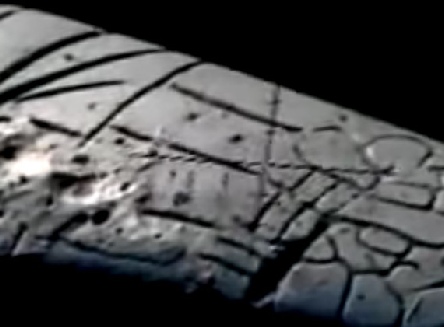
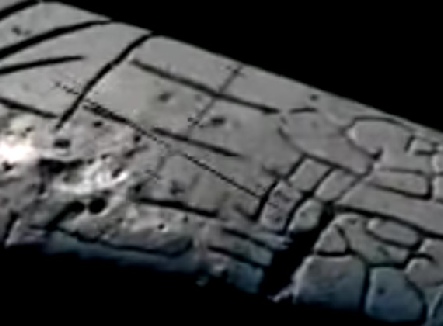
After this pseudo-
Here’s a compilation of screenshots of the LM in the footage (below left), compared with part of a composite image from Apollo 11:
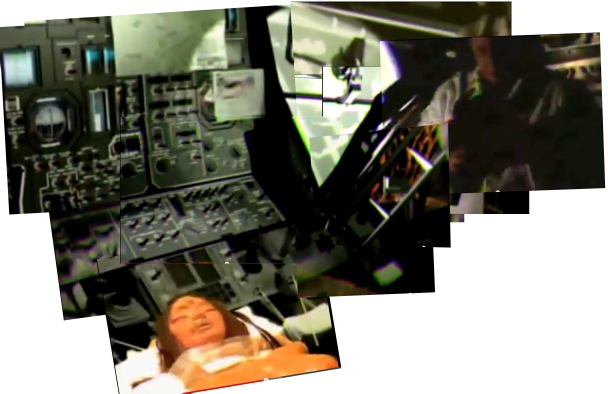
As you can see, the LM in the film is very accurate, and while it Is not impossible for it to be a large photographic background, it certainly has the impression of it being a 3-
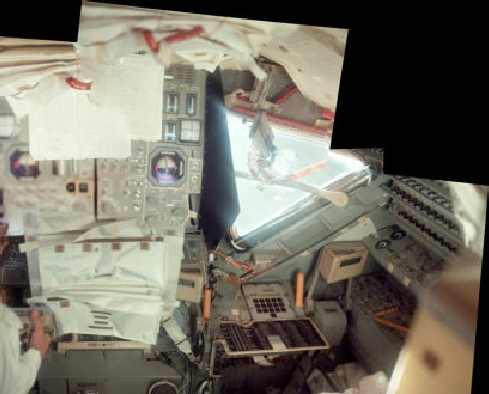
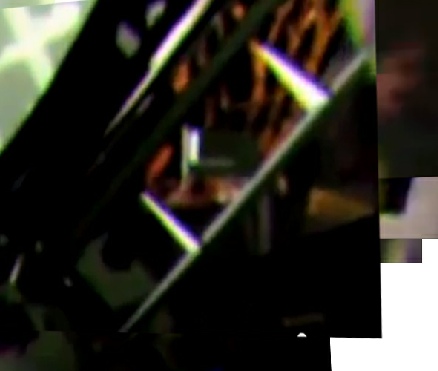
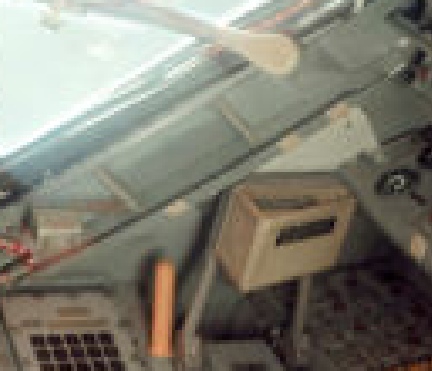
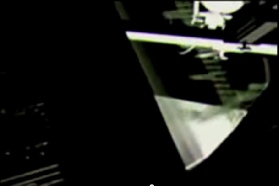
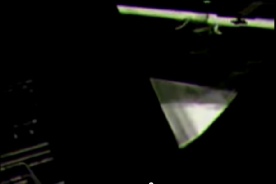
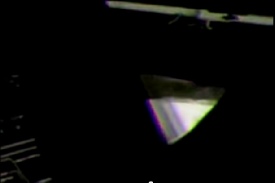
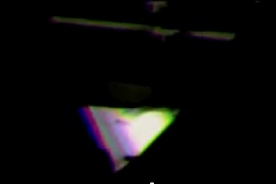
You have to ask: how is this possible in a single, unedited shot? My view is that it isn’t. My view is that the first shot is taken inside a LM mock-
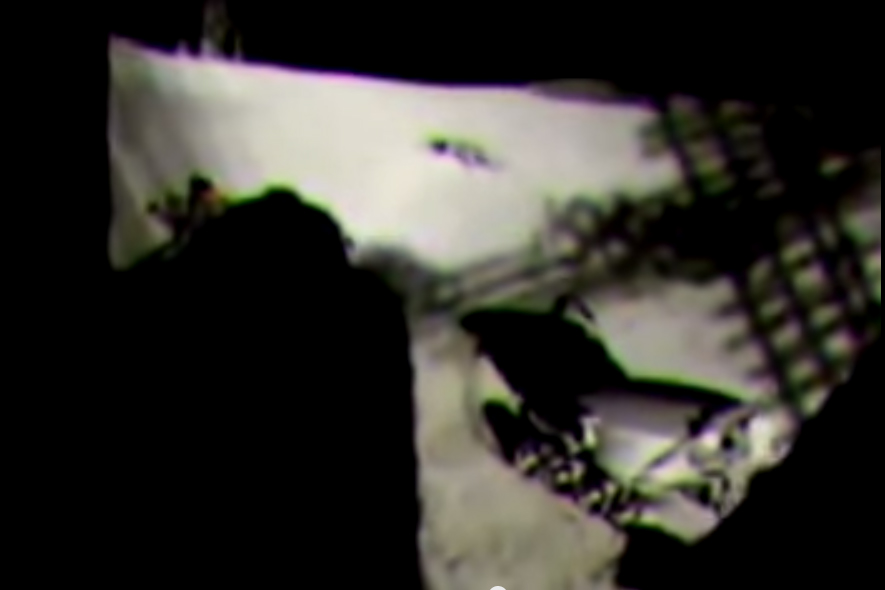
Leaving aside the suddenly change in Landing Point Designator markings on the window, which are white in the previous footage, we have a view showing a lunar module shadow and a a vehicle with several wheels. The vehicle is supposed to be that of a Lunokhod rover, and here’s an example of one from a museum, together with an Apollo image of the LM shadow viewed from inside.

It’s difficult to tell whether the solar panel dish is supposed to be raised or not -
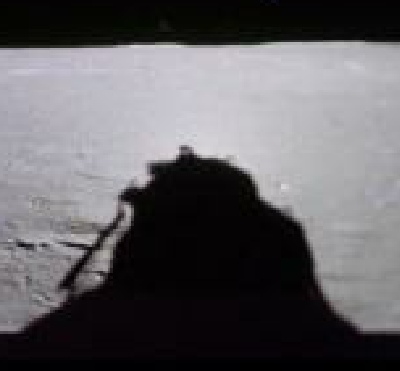
The metal framework also seems to be perpendicular of the body rather than being part of it.
There are also issues with the details on DSKY, the on board computer. Here is a typical example from one of the pre-
The very obvious difference here is the complete lack of any detail on the two panels above the number keys. The genuine example is from Apollo 16, but is absolutely typical of all other versions.
Another difference are the thrust controls either side of the DSKY. In the Apollo 20 film there is an identical joystick either side of the DSKY, whereas in every photograph of an actual lunar module the Commander’s (CDR) position on the left as a joystick while the pilot’s (LMP) position on the right is a twist grip.
One final detail comes from the way that panels 1 and 2 (the panels for the CDR and LMP on the left and right respectively). Again, the Apollo 16 view is absolutely typical.
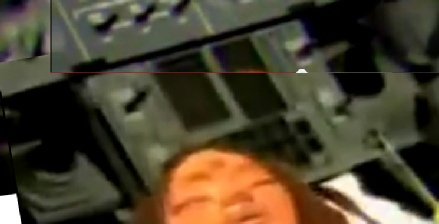

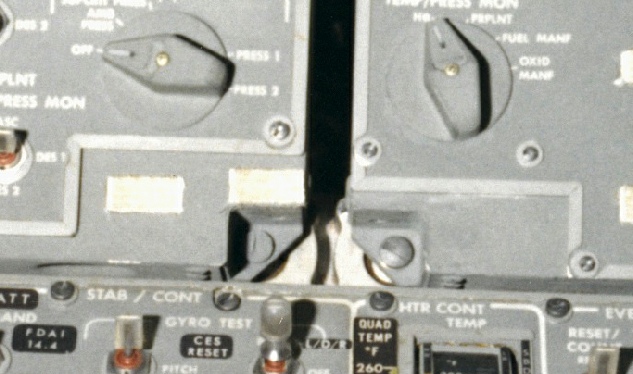
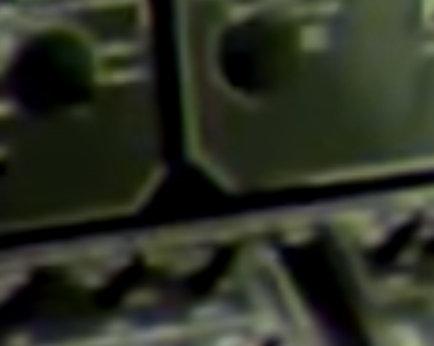
The fake Apollo has the same overall shape as the genuine Apollo one, with the cut off corners, but there the resemblance ends, There is no depth to the panels, nor are there the squared off corners to allow for the recesses for screwing the panels down. The fake also lacks the detailing around the panels, and there are absolutely no screws to be seen anywhere (in fact they seem to be entirely absent throughout the model). It is beginning to look a lot less like a convincing model and more like a series of prints stuck to a cardboard set.
Then there’s the ‘alien’ laid out on some sort of table.
In a real LM there isn’t an awful lot of room, and you have to question how it is possible for there to be enough space for two astronauts and an alien on a slab (and supposedly another one out of shot too), particularly when at least one astronaut is not in his EVA suit. Where is the suit? How was there room to get undressed? The LM is pretty small, as can be seen in this footage from Apollo 11, so there would hardly be room for extra bodies.
More importantly, how did they get the alien in to the LM, given that the hatch is right below her head. While it isn’t impossible, it would certainly be very difficult for two astronauts to manoeuvre a third body through the hatch, get out of their suits and then display her on a table -
The unsuited astronaut that is visible is also a bit of a giveaway. Many films shown of Apollo astronauts feature them spinning objects, including cameras, and this astronaut is doing the same thing. The problem he has is that the camera is behaving exactly as it would in terrestrial gravity, not lunar.
The real giveaway comes when the video tries to film out of the window. There is a very obvious dissolve edit in the view where the supposed lunar horizon visible through the window jumps form one level to another without the interior view changing -
There are even people who have tried to carry on with the fraud, making absolute idiots of themselves in the process.
Youtube user johnmoowalker claims to have found a UFO in Apollo 20’s Descent Orbit Insertion footage. Unfortunately for him, the fact that there is no descent module component to the LM in the video and that one other youtube user (TheFakingHoaxer) made the video openly stating that it was a fake and explaining exactly how it was done has obviously passed him by. Likewise the Apollo 20 EVAs:
And let’s not spend too long dissecting this utter crock:
Again this is supposedly from a mission that stayed on the lunar far side for a week, yet there is no change in LM shadow length over that time, and where the shadow shows different features compared with the orginal fake (legs struts and RCS thrusters on the right had side for one). Here’s the site on the alleged day of liftoff -
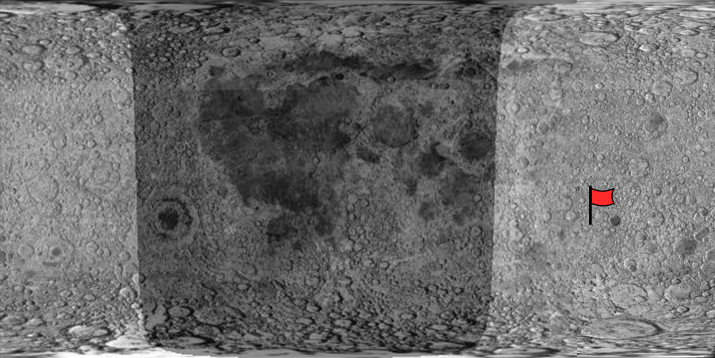
Oh, and have we spotted the flag that stays resolutely upright despite the ascent engine blast?
So, whether this was an elaborate April Fool’s joke or an attempt to deceive with malicious intent, the fact is that it did not happen.
Those UFO enthusiasts who have recognised this fact are justifiably angry about it, alleging either malign intent from the secret government blah blah to hush up genuine UFO activity or just plain old making them look like dicks. Again.
Either way, it’s a fake.


Not to mention one opened n an actual EVA from Apollo 9 -
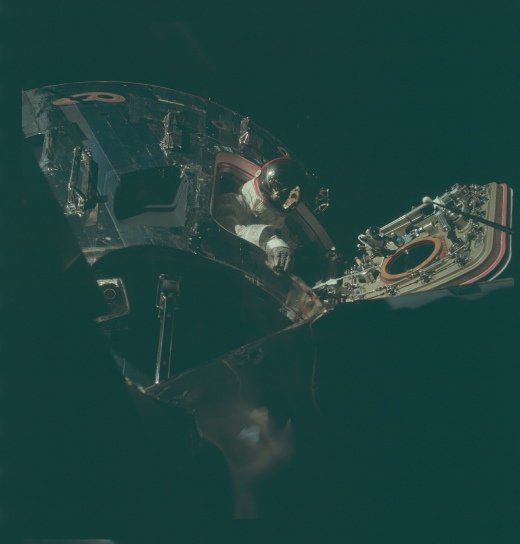
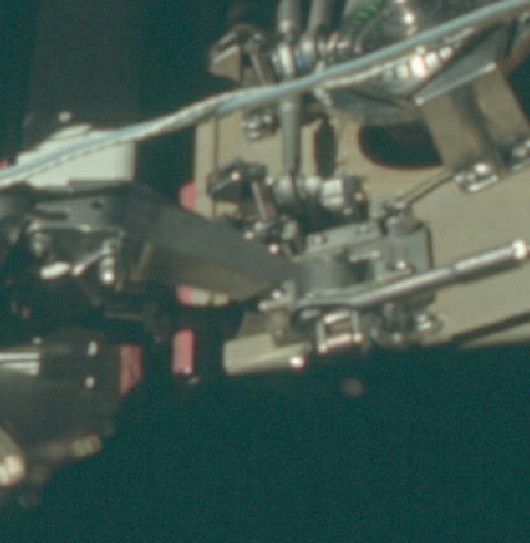
Nothing really conclusive, just to point out that with the right camera set up and access to models and photo resources it would not be a difficult job to create a fake model moon providing your prepared to fudge over the details a bit.
So, leaving aside the fact that the mission supposedly landed on the lunar far side and managed to maintain live comms, telemetry and TV contact with Earth, and the fact that one of the astronauts, Leonov, is still alive and has never actually mentioned anything about this, and that the video was released on April 1st, and that the alleged astronaut whistleblower has never been seen again and has been strongly linked to one Thierry Speth (an artist supposedly specialising in models very similar to the alien) also missing without trace, there are serious errors in the LM footage and outright fakery in the CM footage that clearly marks the whole thing as a fraud.
Other segments of the video not examined here have also been identified as faked, fusing together genuine Apollo images and audio from the near side with illustrations from a book to produce a fake alien settlement:
